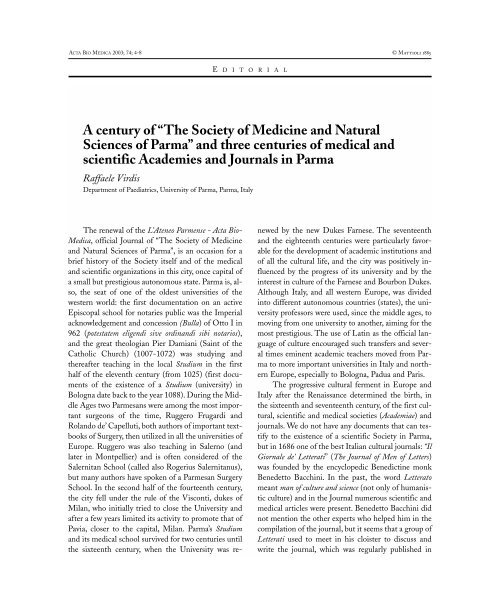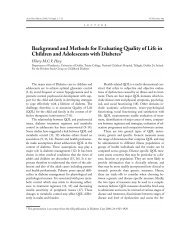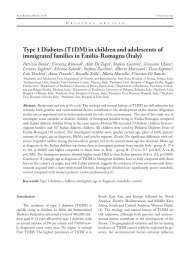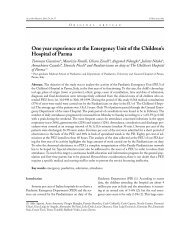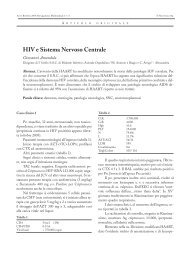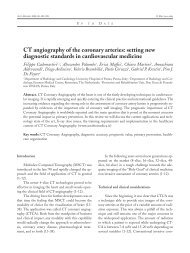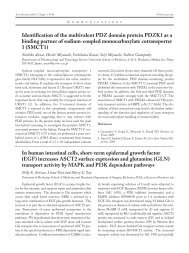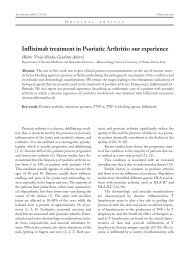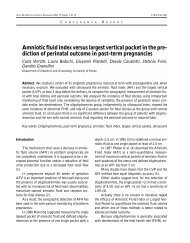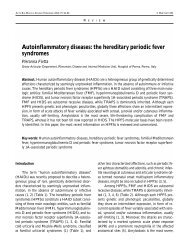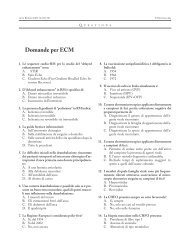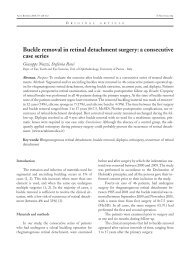famous - Acta Bio Medica Atenei Parmensis
famous - Acta Bio Medica Atenei Parmensis
famous - Acta Bio Medica Atenei Parmensis
You also want an ePaper? Increase the reach of your titles
YUMPU automatically turns print PDFs into web optimized ePapers that Google loves.
ACTA BIO MEDICA 2003; 74; 4-8 © Mattioli 1885<br />
E D I T O R I A L<br />
A century of “The Society of Medicine and Natural<br />
Sciences of Parma” and three centuries of medical and<br />
scientific Academies and Journals in Parma<br />
Raffaele Virdis<br />
Department of Paediatrics, University of Parma, Parma, Italy<br />
The renewal of the L’Ateneo Parmense - <strong>Acta</strong> <strong>Bio</strong>-<br />
<strong>Medica</strong>, official Journal of “The Society of Medicine<br />
and Natural Sciences of Parma”, is an occasion for a<br />
brief history of the Society itself and of the medical<br />
and scientific organizations in this city, once capital of<br />
a small but prestigious autonomous state. Parma is, also,<br />
the seat of one of the oldest universities of the<br />
western world: the first documentation on an active<br />
Episcopal school for notaries public was the Imperial<br />
acknowledgement and concession (Bulla) of Otto I in<br />
962 (potestatem eligendi sive ordinandi sibi notarios),<br />
and the great theologian Pier Damiani (Saint of the<br />
Catholic Church) (1007-1072) was studying and<br />
thereafter teaching in the local Studium in the first<br />
half of the eleventh century (from 1025) (first documents<br />
of the existence of a Studium (university) in<br />
Bologna date back to the year 1088). During the Middle<br />
Ages two Parmesans were among the most important<br />
surgeons of the time, Ruggero Frugardi and<br />
Rolando de’ Capelluti, both authors of important textbooks<br />
of Surgery, then utilized in all the universities of<br />
Europe. Ruggero was also teaching in Salerno (and<br />
later in Montpellier) and is often considered of the<br />
Salernitan School (called also Rogerius Salernitanus),<br />
but many authors have spoken of a Parmesan Surgery<br />
School. In the second half of the fourteenth century,<br />
the city fell under the rule of the Visconti, dukes of<br />
Milan, who initially tried to close the University and<br />
after a few years limited its activity to promote that of<br />
Pavia, closer to the capital, Milan. Parma’s Studium<br />
and its medical school survived for two centuries until<br />
the sixteenth century, when the University was renewed<br />
by the new Dukes Farnese. The seventeenth<br />
and the eighteenth centuries were particularly favorable<br />
for the development of academic institutions and<br />
of all the cultural life, and the city was positively influenced<br />
by the progress of its university and by the<br />
interest in culture of the Farnese and Bourbon Dukes.<br />
Although Italy, and all western Europe, was divided<br />
into different autonomous countries (states), the university<br />
professors were used, since the middle ages, to<br />
moving from one university to another, aiming for the<br />
most prestigious. The use of Latin as the official language<br />
of culture encouraged such transfers and several<br />
times eminent academic teachers moved from Parma<br />
to more important universities in Italy and northern<br />
Europe, especially to Bologna, Padua and Paris.<br />
The progressive cultural ferment in Europe and<br />
Italy after the Renaissance determined the birth, in<br />
the sixteenth and seventeenth century, of the first cultural,<br />
scientific and medical societies (Academiae) and<br />
journals. We do not have any documents that can testify<br />
to the existence of a scientific Society in Parma,<br />
but in 1686 one of the best Italian cultural journals: “Il<br />
Giornale de’ Letterati” (The Journal of Men of Letters)<br />
was founded by the encyclopedic Benedictine monk<br />
Benedetto Bacchini. In the past, the word Letterato<br />
meant man of culture and science (not only of humanistic<br />
culture) and in the Journal numerous scientific and<br />
medical articles were present. Benedetto Bacchini did<br />
not mention the other experts who helped him in the<br />
compilation of the journal, but it seems that a group of<br />
Letterati used to meet in his cloister to discuss and<br />
write the journal, which was regularly published in
Editorial<br />
5<br />
Parma for five years. After that, Bacchini was summoned<br />
to Modena by the Duke of that city as chief of<br />
his prestigious library (Biblioteca Estense). He moved<br />
to the new position with his Journal, where he started<br />
to publish also the names of the Editorial Board:<br />
among them the physician Bernardino Ramazzini. He<br />
is considered to be the father of modern occupational<br />
medicine and had studied Medicine in Parma prior to<br />
his return to his home town, the city of Modena,<br />
where he contributed to re-opening the local university<br />
and the medical school (1, 2).<br />
In the seventeenth century in Parma a “College<br />
for Noblemen” (Collegio dei Nobili) was also instituted<br />
and soon became very <strong>famous</strong>; it was attended by<br />
many young noble students from all over Europe, especially,<br />
but not only, from catholic countries and<br />
among them many future crowned heads. In this College,<br />
which in its most fertile period was attended by<br />
almost 600 students, an Academy of scholars and best<br />
students called “Accademia degli Scelti” was founded in<br />
1672 with three section, literary, military and scientific,<br />
also with interests in medicine.<br />
The following century, the eighteenth, was very<br />
important for Parma from a cultural point of view; the<br />
last member of the Farnese family, Elisabetta, married<br />
the king of Spain, Philip V Bourbon and in 1732 the<br />
Duchy of Parma came under the government of the<br />
Bourbon family. The new Dukes, Carlo I (1732-<br />
1734), Elizabeth’s eldest son, later to become King of<br />
Naples and of Spain, his brother Philip (1748-1765)<br />
and his son, Ferdinando (1765-1802), brought a new<br />
French style of life to Parma, particularly in the cultural<br />
field. The Prime minister was the Frenchman<br />
Guillaume Du Tillot, an honest and competent politician<br />
and administrator, who summoned from all over<br />
Italy and from his own country men of culture (such<br />
as the <strong>famous</strong> philosopher Condillac as teacher of the<br />
young Duke Ferdinando), competent physicians and<br />
other professionals and skilled craftsmen (3). To improve<br />
the medical level of the local hospital and of the<br />
various physicians of the ducal court a “Physioanatomic<br />
Academy” (Accademia fisio-anatomica) was instituted,<br />
transforming an anatomy theater or laboratory<br />
to something more general where the human body<br />
was studied from the point of view of its functions and<br />
diseases. This was legalized in 1751 by a law (leges<br />
Academiae Hospitalis) which helped to reform both the<br />
Hospital and the <strong>Medica</strong>l faculty (3). Chief of the<br />
Academy was the Chief physician (Protomedico generale)<br />
of the Duke and Dean of the faculty. According<br />
to its rules, the Academy members had to meet every<br />
week, alternating physiology and anatomy with clinical<br />
discussions. Attendance at the Academy was<br />
mandatory for all the professors of the medical faculty<br />
and for the physicians of the hospital and of the<br />
Ducal court (3-5). Many meetings were open to all<br />
educated people and they were probably well attended<br />
because the population of the Duchy was very interested<br />
in all aspects of culture and, at that time, it was<br />
the single foreign country with the highest number of<br />
subscriptions to the Encyclopédie of Diderot and<br />
D’Alambert.<br />
Unfortunately, we do not have minutes or reports<br />
of these meetings, but we know that the mean level of<br />
general and academic medicine improved and many<br />
professors of the local or other universities continued<br />
to report in their curricula vitae their membership of<br />
the Parma Academy. In the same years, exactly in<br />
1757, the glorious Accademia di Belle Arti (further<br />
sponsor of the Accademia di Brera in Milan) was also<br />
founded and some professors of Anatomy were members<br />
and teachers of both institutions.<br />
Furthermore, a few years later, in 1765 one of the<br />
first Italian journals completely devoted to Medicine,<br />
the Gazzetta <strong>Medica</strong> (The <strong>Medica</strong>l Gazette) was founded.<br />
Initially it was mostly a translation from a Belgian<br />
medical Journal with a few original reports, but these<br />
progressively increased in the following issues. The<br />
Journal, also published in Venice with minimal differences,<br />
was well prepared and was attracting memories<br />
and letters from all parts of Italy. The Prime minister<br />
was proud of its success and a few articles were cited<br />
and translated in the French journals. Nevertheless the<br />
Gazette ended its publication in Parma after only<br />
three years without any explanation (1, 2).<br />
Du Tillot lost his appointment in 1771 but, before<br />
his leaving, he reformed the whole University, removing<br />
it from the supervision of the Jesuit order, and<br />
renewed the medical faculty calling as Dean Michele<br />
Girardi, Professor in Padua and former best student<br />
of the great G.B. Morgagni, and many other physicians<br />
from France, among them François-Guillaume
6 R. Virdis<br />
Levacher, as chief obstetrician and surgeon. After the<br />
dismissal of Du Tillot the Accademia probably limited<br />
its activity to the teaching of Anatomy, but it had given<br />
a strong impulse to the medical world of Parma, also<br />
including the habit of sending the best students<br />
and young physicians to attend abroad important universities<br />
of Italy, France, Germany and England.<br />
These physicians, such as the clinicians Rasori, Rubini<br />
and Tommasini, the surgeons Ambri and Mistrali.<br />
and the obstetrician Rossi were among the most <strong>famous</strong><br />
in Italy between the end of the eighteenth century<br />
and the beginning of the nineteenth. Exactly at<br />
the beginning of the new century, in 1804, while all<br />
Northern Italy was under Napoleonic rule, these new<br />
scientists with some old masters from the Du Tillot<br />
age and of the previous Accademia fisio-anatomica<br />
founded a new scientific association called Società<br />
medico-chirurgica di Parma (Society of Medicine and<br />
Surgery) (6). With respect to the previous academy,<br />
which was never condidered as a precursor, the new<br />
society was instituted by the initiative of the physicians<br />
and not by the rulers, nobody was obliged to attend<br />
the meetings, and they were not devoted to one<br />
single area (anatomy).<br />
Ettore Ponzi in a brief history of the “Società di<br />
Medicina e Scienze Naturali di Parma” (6) affirmed<br />
that the new <strong>Medica</strong>l Society had been constituted,<br />
under the auspices of Mederique Moreau de Saint-<br />
Mery, chief of the new French government of the old<br />
Duchy, by the most important physicians in the city,<br />
the university Professors Pietro Rubini, Giacomo<br />
Tommasini, Giuseppe Ambri and the elderly French<br />
Obstetrician F-G. Levacher. In 1806 the Society<br />
started the publication of a Journal (Il Giornale della<br />
Società Medico-Chirurgica di Parma) which continued<br />
publishing original articles (Articoli della Società) summaries<br />
and reviews from other medical journals and<br />
books (Letteratura <strong>Medica</strong>) until 1815. Among various<br />
clinical and pharmacological articles, there were discussions<br />
on topics of major interest in that moment,<br />
like vaccinations and the medical theory of “controstimolo”,<br />
the Italian elaboration of the doctrine of the<br />
Scotch physician John Brown, that had in the Parmesan<br />
Giovanni Rasori and Giacomo Tommasini the<br />
main exponents. The journal was written in Italian, although<br />
the old Duchy was at that time a department<br />
of the French Empire, like Piedmont and Liguria, and<br />
French was the official language, mandatory for all<br />
public acts.<br />
In 1814 the former Duchy of Parma, Piacenza<br />
and Guastalla was assigned to Marie Louise (the<br />
beloved Maria Luigia for the Parmesans), wife of the<br />
defeated ruler, Napoleon, and daughter of the Emperor<br />
of Austria Franz I of Habsburg-Lorraine: the old<br />
institutions were reformed and the University renewed.<br />
Shortly after, in 1815, the journal stopped<br />
publication, but in the following years news of the activity<br />
of the Society continued to appear in the local<br />
newspaper “La Gazzetta di Parma”.<br />
After Pietro Rubini’s death, in 1819, we do not<br />
find any more news about the Society, but most of the<br />
former members were still active in another cultural<br />
institution founded among others by G Tommasini, in<br />
1815: “Il Gabinetto Letterario” (The Literary Room )<br />
with the goals of inducing “ meetings of people interested<br />
in literature and sciences” and of propagating “useful<br />
knowledge”. Among the various Presidents the association<br />
had since its beginning, there were the physicians<br />
Pietro Rubini and Joseph Frank. The Gabinetto<br />
was closed in 1831 by the Ducal government because<br />
of the independence insurrections of that year; it was<br />
reconstituted in 1840 by Professor Giorgio Jahn, Director<br />
of the Botanic Garden, but disappeared a few<br />
years later. The following years were rich in political<br />
meaning for the independence and unification of Italy<br />
and in Parma, as in the rest of Italy, many physicians<br />
were among the most fervent patriots preferring civil<br />
to scientific involvement. Moreover, local government<br />
blocked any kind of association, even literary or scientific,<br />
trying to oppose the spread of patriotic feelings.<br />
Cultural enterprises restarted after the unification of<br />
Italy in 1860, and a “Circle of scientific reading” (Circolo<br />
di Letture scientifiche) was instituted; it soon set up an<br />
up-to-date library with many scientific books and<br />
journals and was attended by most of the professors of<br />
the medical and scientific faculties, and by many<br />
physicians of the city. The “Circle” in 1869 merged<br />
with the richer Casino di Lettura (The Reading House)<br />
forming the Society of the Casino di Lettura and continuing<br />
to subscribe scientific and medical journals, to<br />
improve the library and to organize scientific meetings<br />
and discussions among its members.
Editorial<br />
7<br />
In 1887, the Professors of the <strong>Medica</strong>l faculty<br />
founded a new medical journal called “L’Ateneo Medico<br />
Parmense” published for 5 years until 1891. The Journal<br />
wanted to have a nationalistic character, trying to<br />
stress the role of Italian medical observations and research<br />
in a period in which the best Italian scientists<br />
were yet publishing their studies in foreign journals. In<br />
the first issues references to previous Parmesan medical<br />
journals and Societies and to local medical glories<br />
like Rasori and Tommasini were clear. The Journal<br />
stopped its publication probably because of the transfer<br />
of the first director, Giuseppe Sivestrini to another<br />
university but it was time to restart a new <strong>Medica</strong>l Society,<br />
which was re-founded in 1899 by the medical<br />
faculty and by the local section of the Ordine dei Sanitari<br />
(the college of all physicians of Italy) which had been<br />
publishing a Bollettino (Bulletin ) since 1898. The society<br />
was called “Associazione Medico-Chirurgica di Parma”<br />
and the first President was the internist Alberto<br />
Riva, and the honorary President was the elderly surgeon<br />
and pathologist Professor Giovanni Inzani<br />
(1827-1902), hero of the independence of Italy and<br />
several times volunteer as soldier and physician in the<br />
wars of Independence and also in peace such as in occasion<br />
of a severe epidemic of cholera.<br />
Since its foundation, the Society had frequent<br />
meetings attended by numerous members and of other<br />
physicians of the university and of the hospital. The<br />
communications had been published since the beginning<br />
in a bulletin, initially called “Rendiconti dell’Associazione<br />
Medico-Chirurgica di Parma”. The Association<br />
had more than 100 members, who increased with the<br />
years, as also its scientific importance was growing. In<br />
1908 it changed its name to Società <strong>Medica</strong> to open the<br />
membership also to experts in allied sciences such as<br />
biologists, chemists, pharmacists and veterinarians. In<br />
the same year, the Society changed the title of its bulletin<br />
to “Bollettino della Società <strong>Medica</strong> di Parma” which<br />
rapidly became one of the most important national<br />
medical journals. The new society, founded only a few<br />
years before, but with prestigious precedents in the<br />
XVIIIth and XIXth century, if not also in the XVIIth,<br />
had become in the first decades of life the most important<br />
scientific association in the city and was attended<br />
by different professionals in the field of life sciences.<br />
In 1928 its name was again changed, as was that<br />
of the Bollettino. The new Bulletin was called L’Ateneo<br />
Parmense and the physiologist Mario Camis was appointed<br />
as director by the assembly of members.<br />
Camis was the beginner of a prestigious and still active<br />
Parmesan school of neurophysiology, which has<br />
counted among its exponents world <strong>famous</strong> names as<br />
Giuseppe Moruzzi, Pietro Arduini, and Giacomo<br />
Rizzolatti, all active members of the Society. Since<br />
then, the Society and the Journal have had an active<br />
life, even though in the last years of internalization<br />
and superspecialization of medicine the importance of<br />
general scientific societies, especially if of local interest,<br />
has decreased progressively. L’Ateneo Parmense<br />
continued to receive many papers for publication from<br />
local and other researchers from all over Italy and<br />
abroad, and in 1965 started publishing two different<br />
editions, one of exclusively medical interest and the<br />
other oriented to basic sciences, called respectively:<br />
“<strong>Acta</strong> <strong>Bio</strong>-<strong>Medica</strong>” and “<strong>Acta</strong> Naturalia of “L’Ateneo<br />
Parmense”.<br />
The medical edition of the journal has been indexed<br />
since the seventies in Excerpta <strong>Medica</strong>, Index<br />
Medicus and further also in other references lists like<br />
Medline and Embase, both on paper and on web.<br />
Probably in the third millenium a local scientific<br />
academy, as our Society is, cannot aspire to an international<br />
or leading role, but can certainly be an important<br />
way of meeting fellow scientists and a stimulus<br />
to scientific incentive, especially for young researchers.<br />
Furthermore, the continuous subspecialization of<br />
medicine could remove from the young scientists the<br />
possibility of a global maturation and an up-to-date<br />
preparation in general aspects of science, with the<br />
danger of not using general knowledge acquired in<br />
other fields for their own research. Exactly these goals<br />
pushed the scientists of the sixteenth and seventeenth<br />
centuries to found the first academies and scientific<br />
journals.
8 R. Virdis<br />
References<br />
1. Bédarida H. La “Gazzetta <strong>Medica</strong>” di Parma. Contributo<br />
alla storia della Medicina nel sec. XVIII. Archivio Storico per<br />
le Province Parmensi 1925; XXV: 179-222.<br />
2. Virdis R. Sono nate a Parma le prime Riviste medico-scientifiche<br />
italiane Parma <strong>Medica</strong> 2000; 5: 30-4.<br />
3. Bedarida H. Parma e la Francia (1748-1789). SEGEA Editrice,<br />
Parma 1986: 404.<br />
4. Trombara C: Rapporti tra Ospedale e Università in Parma<br />
nel XXVII e XVIII secolo (Un’Accademia di Anatomia nell’Ospedale<br />
della Misericordia). In “Atti Primo Congresso<br />
Italiano di Storia Ospedaliera, Reggio Emilia, 1956: 767-<br />
80.<br />
5. Banzola MA: L’Ospedale vecchio di Parma. Parma 1980:<br />
66-167.<br />
6. Ponzi E. Per la Storia della Società, in “La Società di Medicina<br />
e Scienze naturali di Parma”. L’Ateneo Parmense 1934; 6<br />
(6s): 5-24.<br />
Received: 10 January 2003<br />
Accepted in original form: 15 March 2003<br />
Correspondence: Prof. Raffaele Virdis<br />
Department of Pediatrics, University of Parma<br />
Via A. Gramsci, 14<br />
43100 Parma, Italy<br />
Tel: +39 0521 702782<br />
Fax: +39 0521 290458<br />
E-mail: raffaele.virdis@unipr.it


